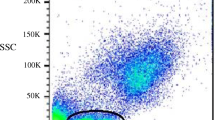Abstract
There is a strong need for generation and publication of reference values of immunotoxicity parameters within experimental and toxicological areas. This is particularly true where the type of distribution of reference values and thus the statistical method to be employed is often unknown and will become necessary if current official proposals to implement immune parameters into regulatory toxicity studies are adopted.
T and B lymphocytes were identified and quantitated by Fluorescence Activated Cell Sorter Analysis (FACS, using either one or two colours) after labelling of lymphocytes in suspension with fluorescent monoclonal antibodies (MoAbs). For single labelling of T and B lymphocytes, fluorescein isothiocyanate (FITC)-conjugated monoclonal antibody (MoAb) Ox-19 and Mark-1 were used respectively. In double labelling, T and B lymphocytes were identified with phycoerythrin (PE)-conjugated Ox-19 and FITC-conjugated Mark-1 MoAbs respectively. The physicochemical stability shelf-life of labelled T lymphocytes was at least 24 h at 2–8°C permitting overnight storage before FACS analysis, whereas enumeration of B lymphocytes should preferably be done directly after labelling. The sum of the percentages of T and B lymphocytes obtained in the combined T+B lymphocyte analysis with FITC-conjugated Ox-19 and Mark-1 were compared with the sum of values obtained in separate experiments after single labelling, yielding an inaccuracy of 0.3%. The precision of B and T cell analysis after double labelling was found to be 8.2% and 0.5% respectively.
Baseline data (reference/normal values) were obtained for rat T lymphocytes (63%–90%) and for B lymphocytes (7.5%–28%).
Similar content being viewed by others
References
Bhat NM, Kantor AB, Bieber MM et al. (1992) The ontogeny and functional characteristics of human B-1 (CD5-positive B) cells. Int Immunol 4:243–252
Bleavins MR, Dziedzic D (1990) An immunofluorescence study of T and B lymphocytes in ozone-induced pulmonary lesions in the mouse. Toxicol Appl Pharmacol 105:93–102
Bloksma N, Schuurman HJ (1989) Basic mechanisms of adaptive immune system function. In: Kammuller ME, Bloksma N, Semen W (eds) Autoimmunity and toxicology; immune disregulation induced by drugs and chemicals. Elsevier, Amsterdam, pp 37–65
Cao W, Sikorski EE, Fuchs BA et al. (1990) The B lymphocyte is the immune cell target for 2′,3′-dideoxyadenosine. Toxicol Appl Pharmacol 105:492–502
Davis D, Safe S (1990) Immunosuppressive activities of polychlorinated biphenyls in C57BL/6N mice: structure-activity relationship as Ah receptor agonists and partial antagonists. Toxicology 63:97–111
Descotes J (1988) Immunotoxicity of pharmaceutical drugs. In: Descotes J (ed) Immunotoxicology of drugs and chemicals. Elsevier, Amsterdam, pp 19–296
Donahoe RM (1990) In vitro immunotoxicology and immunopharmacology: studies on drugs of abuse. Toxicol Lett 53:265–268
Dorken B, Moller P, Pezzutto A et al. (1989) B-cell antigens: section report. In: Knapp (ed) Leukocyte typing IV. White cell differentiation antigens. Oxford University Press, Oxford, pp. 15–32
Evans GO, Flynn RM, Lupton JD (1988) An imunogold cell labelling method for rat T lymphocytes. Lab Anim 22:332–334
Gobin SJP, Legg RF, Paine AJ et al. (1989) The effect of 2-acetyl-4-tetrahydroxybutylimidazole on lymphocyte subsets in peripheral blood of the rat. Int J Immunopharmacol 11:937–946
Grey HM, Sette A, Buns S (1989) How T cells see antigen. Sci Am November: 38–46
Haggerty HG, Holsapple MP (1990) Role of metabolism in dimethylnitrosamine-induced immunosuppression: a review. Toxicology 63:1–23
Houben G, Kuijpers M, van Loveren H et al. (1989) Immunotoxic effects of the food additive ammonia caramel. Symposium Immunotoxicology. Tox 89, The Hague. The Netherlands, November 3, 1989
Jones S (1989) Flow cytometry: applications in research and medicine. Immunochemica 3:1–4
Kammuller ME, Bloksma N, Seinen W (1989) Toxicological considerations on immune disregulation induced by drugs and chemicals. In: Kammuller ME, Bloksma N, Seinen W (eds) Autoimmunity and toxicology; immune disregulation induced by drugs and chemicals. Elsevier, Amsterdam, pp 443–457
Kroese FGM, Butcher EC, Lalor PA et al. (1990) The rat B cell system: the anatomical localization of flow cytometry-defined B cell subpopulations. Eur J Immunol 20:1527–1534
Misra R, Bloom S (1991) Roles of dosage, pharmacokinetics, and cellular sensitivity to damage in the selective toxicity of cyclophosphamide towards B and T cells in development. Toxicology 66:239–256
Ohsawa M, Sato K, Takahashi K et al. (1983) Modified distribution of lymphocyte subpopulation in blood and spleen from mice exposed to cadmium. Toxicol Lett 19:29–35
Ohsawa M, Takahashi K, Otsuka F (1988) Induction of anti-nuclear antibodies in mice orally exposed to cadmium at low concentrations. Clin Exp Immunol 73:98–102
Pharmacia (1988) Directions for use of Ficoll-Paque for in vitro isolation of lymphocytes. Pharmacia LKB Biotechnology AB, Uppsala, Sweden, no. 11-B-018–09
Pillai RM, Watson RR (1990) In vitro immunotoxicology and immunopharmacology: studies on drugs of abuse. Toxicol Lett 53:269–283
Salemink PJM (1990) Cell and cell constituent freeze-drying: fundamentals and principles. In: Smit Sibinga CTh, Das PC, Meryman HT (eds) Cryopreservation and low temperature biology in blood transfusion. Kluwer Academic, Dordrecht, The Netherlands pp 25–54
Smialowicz RJ, Riddle MM, Rogers RR et al. (1990) Immune alterations in rats following subacute exposure to tributyltin oxide. Toxicology 64:169–178
Vos JG, de Klerk A, Krajnc EI et al. (1990) Immunotoxicity of bis(trin-butyltin)oxide in the rat: effects on thymus-dependent immunity and on nonspecific resistance following long-term exposure in young versus aged rats. Toxicol Appl Pharmacol 105:144–155
Waldmann TA (1988) Humoral immunity in man: from the gene to the bedside. In: Krijnen HW, Strengers PFW, van Aken WG (eds) immunoglobulins. Proceedings of an International Symposium. Central Laboratory of The Netherlands Red Cross, Blood-transfusion Service, Amsterdam, pp 15–43
Author information
Authors and Affiliations
Rights and permissions
About this article
Cite this article
Salemink, P., Doorstam, D., Maris, J. et al. Analytical aspects of FRCS (Fluorescence Activated Cell Sorter) identification of rat T and B peripheral lymphocytes in toxicity studies. Comparative Haematology International 2, 220–226 (1992). https://doi.org/10.1007/BF00216098
Received:
Accepted:
Issue Date:
DOI: https://doi.org/10.1007/BF00216098




